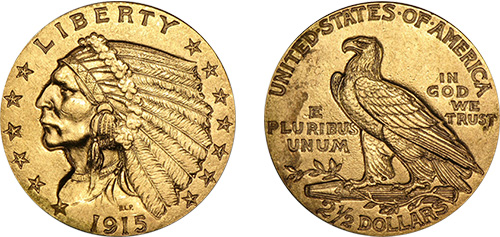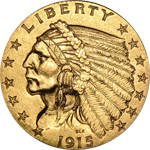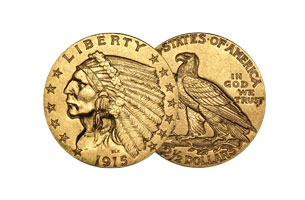The Indian Head quarter eagle and the Indian Head half eagle are one of the most iconic gold coins ever produced by the U.S. Mint. While the Saint-Gaudens double is probably the most famous one of the series and arguably the most artistically accomplished coin in U.S. history, Indian Head half quarter eagles are remarkable for their innovative minting process. The series also includes a $10 gold eagle coin, which was originally designed by Saint-Gaudens and bears the profile of Lady Liberty instead of a male Native American.
The Indian Head $2.50 is mostly distinctive because, along with the $5 coin, it has a sunken instead of a raised design. Roosevelt consulted with his friend William Sturgis Bigelow, a Boston doctor and art enthusiast, about the design of the new American gold coinage. Dr. Bigelow admired the ancient Egyptian relief designs that he had seen at the Boston Museum of Fine Arts. Hence, he took it upon himself to commission another Bostonian, sculptor Bela Lyon Pratt, to create an initial design for the new coins. This is actually the reason why these Indian Heads also are referred to as Pratt-Bigelow coins. While Saint-Gaudens had created individual designs for the double eagle and eagle respectively, Pratt used the same design for both the quarter eagle and half eagle. NGC explains that the iconic nature of the design justified additional exposure by using it on two coins.

The obverse side thus features a male Native American wearing a traditional headdress. The motto LIBERTY is stamped across the top while thirteen stars circle both sides. The mint date is found at the bottom. The reverse side shows an eagle standing in repose. The animal is clutching arrows and an olive branch, symbolizing both the country’s desire for peace and preparedness for war. If there is a mintmark, it left of the eagle’s feet. Since only the mints in Philadelphia and Denver produced this coin, there is either no mintmark or a D for Denver. Pratt also managed to incorporate four different inscriptions — “2 ½ DOLLARS,” E PLURIBUS UNUM,” “THE UNITED STATES OF AMERICA,” and “IN GOD WE TRUST” — on the reverse side of this fairly small coin. Still, the design looks balanced and clean — no small feat in those pre-computer days.
Each Indian Head quarter eagle consists of 90% gold and 10% copper.
The U.S. Mint pressed the Indian Head $2.50 coin between 1908 and 1915, then stopped production for a decade before resuming it again in 1925. In 1929, the Wall Street crash halted production once more. The gold recall of 1934 ended any hope that quarter eagles would ever return. In fact, this was the last $2.50 gold coin ever pressed for circulation. However,
NGC clarifies that coins struck right after production recommenced in 1925 were widely saved and are thus commonly available today. Perhaps collectors expected production to cease again and realized they had a chance to pick up collectable coins at face value. The 1925-D is the most common of the series and can be found in a variety of different grades. Overall, there are only 15 date-and-mint combinations (12 from Philadelphia and three from Denver). At a mintage of 55,680, the 1911-D issue is the rarest one of the quarter eagle series. A small amount of matte proofs was also produced from 1908 through 1915, but the coins’ flat matte finish was unpopular and remained largely unsold until the Mint melted them.
While maybe not as impressive as the Saint-Gaudens double eagle, the Indian head quarter eagle is a great choice for coin collectors. The recessed design has protected the coins from excessive wear and the limited number of date-and-mint combinations makes this Indian Head series relatively affordable. The worth of this small gold coin far exceeds the mere melt value of its precious metal content, but buyers should be aware that there are plenty of counterfeit quarter eagles out there. Always consult with a reputable coins expert. While a $2.50 Indian Head does not qualify for a gold IRA, it is still an attractive investment option due to its considerable numismatic value.


